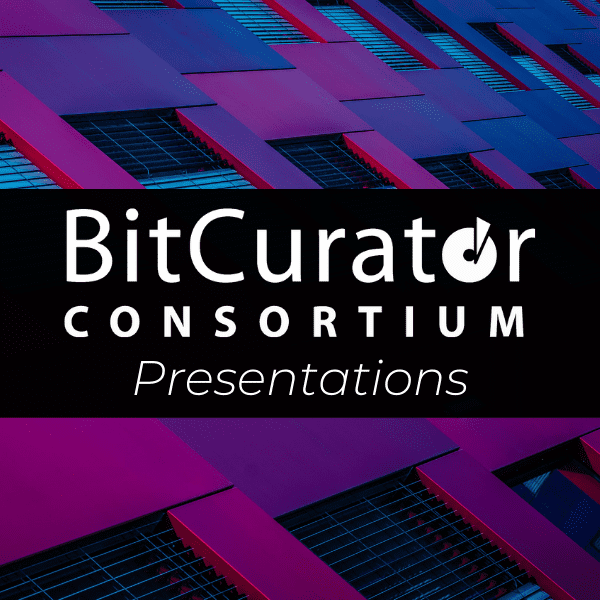Session 4: Access
Carolina Quezada Meneses, Joe Carrano, Kate Dundon, Jess Waggoner | BitCurator Consortium
Talk One: Providing Access to the Christine Tamblyn’s Interactive Digital Artworks: A Case Study (00:00:00)
Carolina Quezada Meneses
As part of my MLIS program internship this year at the UC Irvine Libraries’ Special Collections & Archives (SCA), I helped provide access to the interactive digital artworks of feminist media artist, Christine Tamblyn. Her artwork includes software floppy disks and CD-ROMs, which were formatted to run on early Macintosh operating systems. The artworks combine aspects of academic essay and documentary film with intuitive associations between image, film, text, and sound. These works require some level of input from the user, incorporating a non-linear experience for viewers to choose how long to spend with it, what order to view it in, whether to repeat or skip screens, and whether or not to open buttons. The user chooses their own adventure.
Determined to provide access to these works, I set out to find an emulator that SCA could potentially use to serve its users disk images of the digital artworks. I was able to run the artworks in the Mac OS 9 emulator, Sheepshaver. However, the software was not perfect as it crashed half the time. This led me to the idea of creating screen recordings of my interactions with the programs through the emulator. Through this mediated experience, users can now access her works on a project Google site or Calisphere without being burdened by downloading Sheepshaver.
In my presentation I will talk about my experience and the challenges of providing access to obsolete media as a case study that highlights that “good enough” access is better than no access.
Talk Two: A Serving of ToTS: A Case Study in Management and Access of Legacy Tape Images (00:09:50)
Joe Carrano
The MIT, Tapes of Tech Square (ToTS) collection contains an overwhelming 13 million plus set of digital tape images and files, from timeshare computer backup tapes spanning the early 1970s to the early 1990s. The tape image files were created by a vendor in the early 2000s as part of a project by MIT CSAIL to preserve and regain access to their backups. The vendor created many tape images successfully and CSAIL’s project team extracted many files (albeit not all of them) before transferring the full set to the MIT Libraries in 2017. In addition to being vast and unwieldy, these records are mired in privacy and rights concerns and remain mostly unprocessed by archivists.
This lightning talk will discuss how MIT Libraries has given at least some access to this collection while balancing privacy issues such as fielding requests from original creators to provide them a copy of their files or researchers asking for specific files to be made public. This process also serves as a case study of managing disk/tape images that your archival institution did not create itself or contract with a vendor to create. A short demo will be given for the itstar tool (https://github.com/PDP-10/itstar) for extracting files from ITS dump tapes that is used in this process. Finally, the talk will discuss the steps taken in release of some files in the collection publicly on GitHub (the source code for the game Zork) and any resulting researcher interaction.
Talk Three: From request to access: evaluating born-digital access (00:18:00)
Kate Dundon and Jess Waggoner
Panelists will present an overview of the methodology applied in a recently completed usability assessment of the born-digital access process at the University of California Santa Cruz Library Special Collections & Archives. Digital Projects Librarian Jess Waggoner will discuss the heuristic evaluation work she undertook with an undergraduate student assistant to assess the processes and systems involved in the discovery, request, and access to born-digital archival content. Archivist Kate Dundon will provide an overview of the access procedures and workstation in place at UCSC Special Collections, and discuss how the usability assessment positively impacted local access and processing procedures. She will also address how this work will support future access improvements, particularly in the area of developing greater risk-tolerance for broader access. This project has not been presented previously at any other conference. Audience members will develop a better understanding of usability assessment methodology and how it applies to born-digital access systems. While discussion will focus on examples in an academic library context, the usability concepts addressed can apply to a variety of institution types.
Chat Log Slides
Carolina Quezada Meneses, Joe Carrano, Kate Dundon, Jess Waggoner. (October 15, 2020). Session 4: Access. BitCurator Consortium.